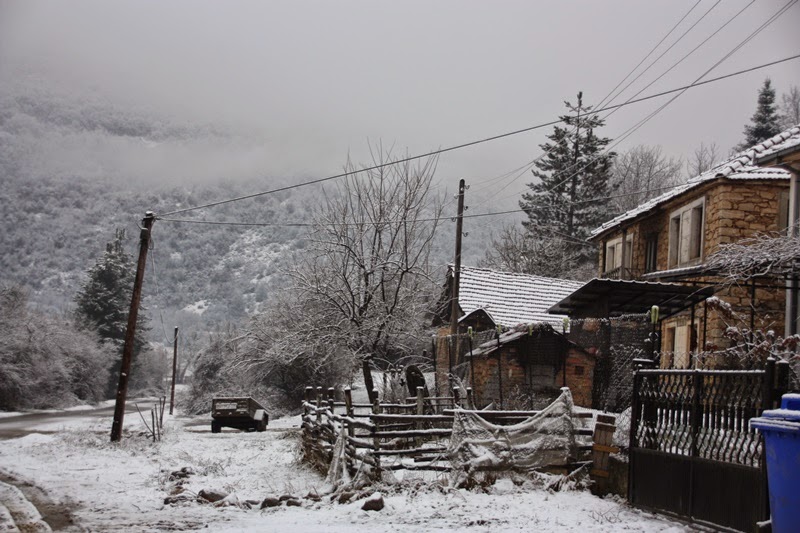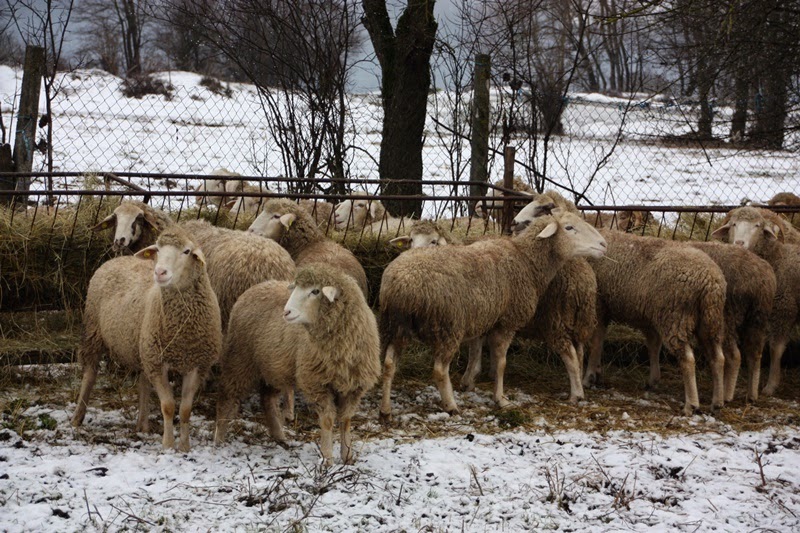As our visit took place during the winter months, we did not get to experience first hand, the summer ritual of going up into the high mountain pastures with the sheep.
Macedonia is a country made up of mountains,
ideal to shepherd and graze livestock.
What we did see was,
what the winter work looks like for the shepherds.
Macedonia is a country made up of mountains,
ideal to shepherd and graze livestock.
What we did see was,
what the winter work looks like for the shepherds.
So, after the grazing season in fall, the flocks come down off the mountains, back into the villages.
The sheep are often kept in older stone barns, with a hay loft above the sheep.
The ewes are housed in group pens,
and often the ewe lambs are kept in a separate group.
The sheep are often kept in older stone barns, with a hay loft above the sheep.
The ewes are housed in group pens,
and often the ewe lambs are kept in a separate group.
 |
| A sheep barn |
These barns are low, so all the feeding happens manually.
Small square bales are fed in hay feeders.
Small square bales are fed in hay feeders.
 |
| Lambs on rolled wheat creep feed |
On some of the farms, the main barn area was used as a central feeding area.
The ewes were let outside, and then group by group the other sheep were let in to eat grain and drink water in the main or biggest part of the barn.
Once done, they were returned to their portion of the barn,
while the another group would be let in to eat.
Once, all the groups have been fed and watered, the original group comes back inside for their grain, hay and water.
The ewes were let outside, and then group by group the other sheep were let in to eat grain and drink water in the main or biggest part of the barn.
Once done, they were returned to their portion of the barn,
while the another group would be let in to eat.
Once, all the groups have been fed and watered, the original group comes back inside for their grain, hay and water.
 |
| Outside feeding area |
Lambing takes place in the group.
The ewes may be separated from the group with their lambs by placing a horizontal panel in the corner of the barn, so that the ewe and her babies can bond.
We saw very few lambing jugs ( only on some of the bigger flocks),
and the newborns and their mom where soon back into the main group of ewes
The ewes may be separated from the group with their lambs by placing a horizontal panel in the corner of the barn, so that the ewe and her babies can bond.
We saw very few lambing jugs ( only on some of the bigger flocks),
and the newborns and their mom where soon back into the main group of ewes
Ewes with very large udders, would be hand milked to reduce the chance of mastitis.
This colostrum, would be used to make a thick, creamy dessert.
 |
| Uncle Ljube, the shepherd, milking. |
The ewes were not milked in a stanchion or parlor,
the shepherd or the owner would simply get a hold of the udder from behind the ewe and start milking into a bucket.
The ewes would stand still while being milked.
As these ewes are hand milked like this for the most part of the year,
they know the routine.
( Our ewes would kick, fight, jump and try and make a run for it.)
The breed of sheep is mostly a mix of the traditional breed crossed with breeds like the East Friesan and Awassi to try and improve milk production.


The shepherds there, are like shepherds here,
if baling twine can fix it, then that is what they use.
Baling twine to hang up feeders,
tie gates together and even to make little makeshift collars to identify some lambs.
the shepherd or the owner would simply get a hold of the udder from behind the ewe and start milking into a bucket.
The ewes would stand still while being milked.
As these ewes are hand milked like this for the most part of the year,
they know the routine.
( Our ewes would kick, fight, jump and try and make a run for it.)
The breed of sheep is mostly a mix of the traditional breed crossed with breeds like the East Friesan and Awassi to try and improve milk production.


The shepherds there, are like shepherds here,
if baling twine can fix it, then that is what they use.
Baling twine to hang up feeders,
tie gates together and even to make little makeshift collars to identify some lambs.
In some areas, the shepherds would still take the ewes out to graze, on some left over grass
shepherding them all the time.
A number of sheep and goats in the flock wear bells.
These bells are hand made,
and the collars around the sheep's neck is traditionally made from wood.
We were gifted some bells with these collars,
and will be hung in our house!
These are to us, works of art!

The shepherds all have a shepherds crook,
the crook is designed so that the crook part can be used to catch a lamb by the hind leg.
We were also gifted a crook, however we needed to leave the stick part behind, as it was too long to take back with us on the plane.
We will hang the crook with the bells in our home.
Thank you to Uncle Ljube, Goce and Destan for these lovely bells and crooks.

The lambs stay on the ewes until they are about 15-20 kgs,
and then get sold at weaning time.
The ewes then head up into the mountains with the shepherds and their dogs.
We were told that the sheep are corralled at night, in the morning before heading out to graze the sheep are hand milked.
The shepherds spend about 30-60 second hand milking each ewe a few times a day.
After the milking, the ewes and the shepherds spend the day grazing until the next round of milking.
The shepherds do try to avoid bumping into other shepherds while up on the mountain.
Bumping into each other while grazing could result in some viscous dog fights, between the various packs
and the mingling of the sheep, is time consuming to sort out.
The shepherds do not use herding dogs at all.
There is no culture of using herding dogs, nor are there any native herding dog breeds in Macedonia.
The sheep are shepherded by being "bonded" to the shepherd, by calling, by the sound of the bells and in some cases by following the guardian dogs.
The shepherds do not use herding dogs at all.
There is no culture of using herding dogs, nor are there any native herding dog breeds in Macedonia.
The sheep are shepherded by being "bonded" to the shepherd, by calling, by the sound of the bells and in some cases by following the guardian dogs.
 |
| Shepherds, dogs and sheep heading out to graze. |
Nowhere are fences.
The ewes are not "let out" into fenced fields to graze, unattended.
All grazing is done with a shepherd at hand.
Nowhere, did we see sheep out grazing in a fenced area, or without a shepherd.
The sheep, were grazed always with a shepherd (or two) with them,
and a group of LGD.

The largest flock we saw was about 300 ewes,
with most flocks being smaller.
bear in mind that these sheep are milked at least twice a day, which is both time consuming and labor intensive.
Most flocks included some goats,
and in some cases a pig, may even be part of the grazing group.
Every single flock we encountered,
had at least 3, but mostly more sheep dogs accompanying the shepherd.
Way more dogs, than what flocks run here in Canada or the USA.
In some places we saw 10 or more dogs with only 100 ewes.

Here are some more pictures from different shepherds, different sheep, different barns.
I think only my "sheep" friends will understand why I feel the need to post so many pictures of sheep, barns, feeders etc.
For, those who don't understand,
well,
just enjoy them.
The ewes are not "let out" into fenced fields to graze, unattended.
All grazing is done with a shepherd at hand.
Nowhere, did we see sheep out grazing in a fenced area, or without a shepherd.
The sheep, were grazed always with a shepherd (or two) with them,
and a group of LGD.

The largest flock we saw was about 300 ewes,
with most flocks being smaller.
bear in mind that these sheep are milked at least twice a day, which is both time consuming and labor intensive.
Most flocks included some goats,
and in some cases a pig, may even be part of the grazing group.
Every single flock we encountered,
had at least 3, but mostly more sheep dogs accompanying the shepherd.
Way more dogs, than what flocks run here in Canada or the USA.
In some places we saw 10 or more dogs with only 100 ewes.

Here are some more pictures from different shepherds, different sheep, different barns.
I think only my "sheep" friends will understand why I feel the need to post so many pictures of sheep, barns, feeders etc.
For, those who don't understand,
well,
just enjoy them.
 |
| The rams |
 |
| These ewes were housed in a "tunnel" type of barn. |
 |
| Every, self respecting sheep farm feels the compelling need to check out the corn silage... as does Eric. By the way this was top quality silage! |
 |
| Simply made grain feeders, two trees and slung in between, heavy conveyor belt rubber. Hung up with baling twine. Cheap, efficient and handy. |
 |
| This was one of the larger flocks we saw, they did use lambing jugs. |
 |
| The beads around this pretty ewes neck is to deflect "the evil eye" |
 |
| A different, more traditional wood and stone barn. |
 |
| The outside feeding area. |
 |
| Grazing the goats |
 |
| A village |
 |
| Sheep barn |
 |
| Another traditional barn |
 |
| A new barn |
 |
| Some scenary, the brown shrubs are mostly oak. |
 |
| Goats |
 |
| Outside feeding, these look like ewe lambs |
 |
| A village in the south part of MAcedonia |
 |
| The corral at the back is made of thornbushes. |
I will end this blog with a few shepherd dogs,
as they will lead me into my Macedonia part 3. |
| Mecedonian Shepherd dogs |








What do they feed the dogs?
ReplyDeleteLouise, What do they do with the sheep milk?
ReplyDeleteThe dogs are fed with what ever they have.
ReplyDeleteThe sheep's milk is made into a feta cheese or a hard yellow cheese - delicious.